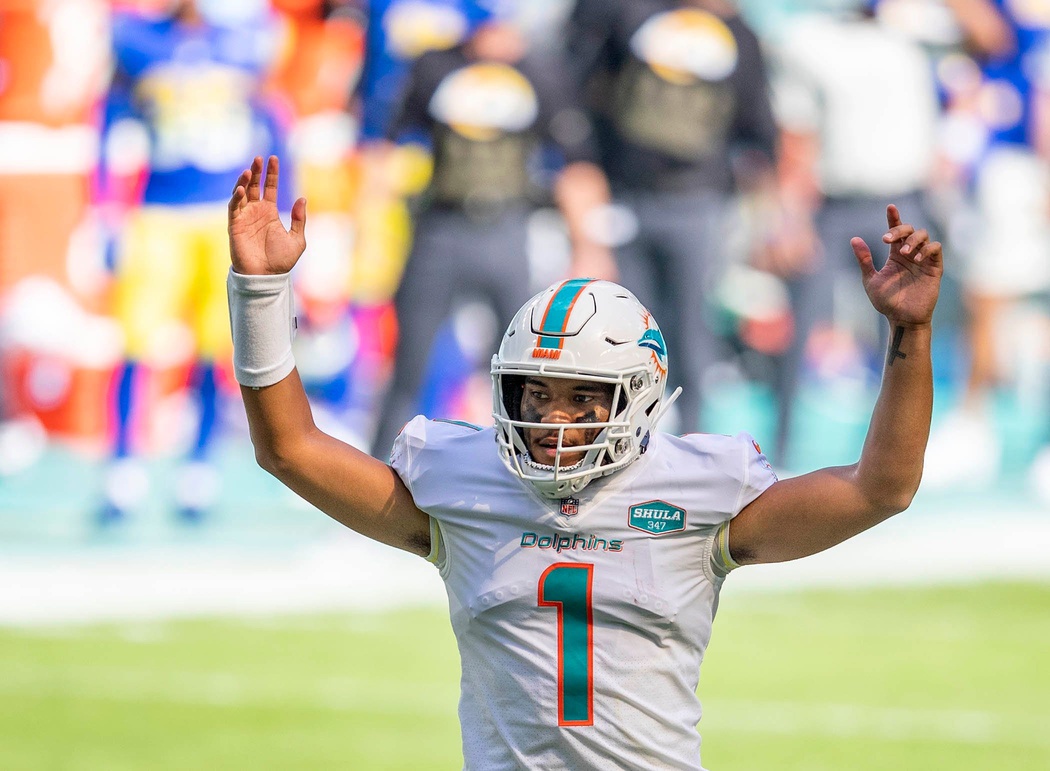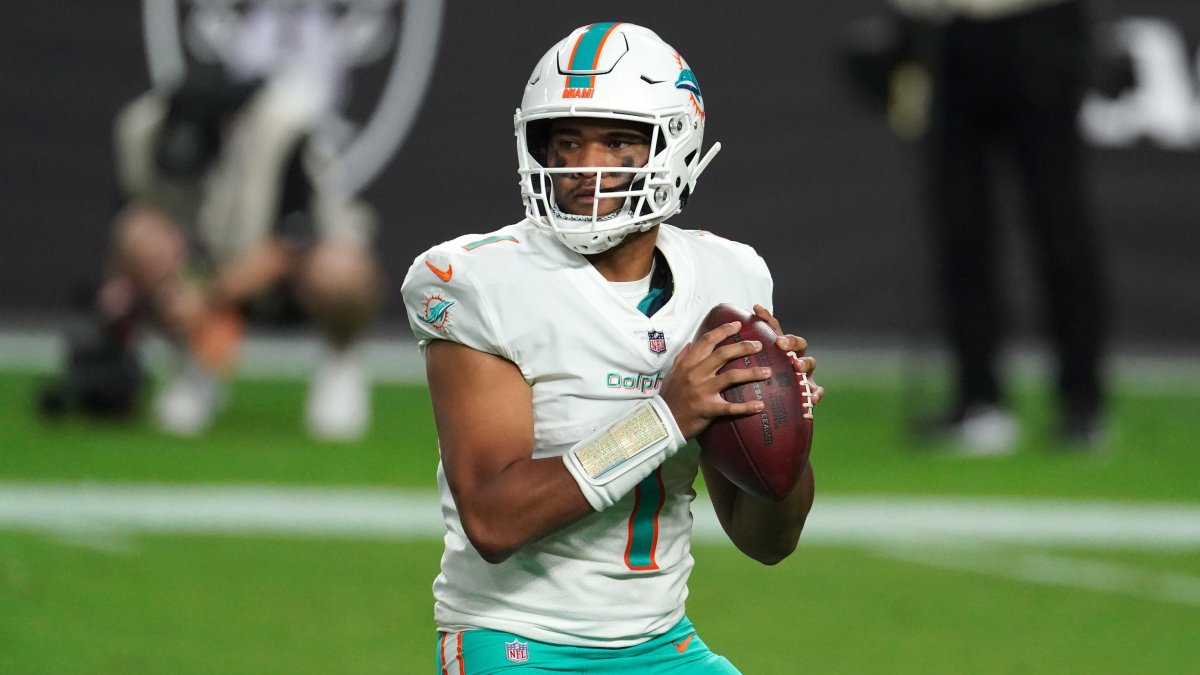There’s not much faith out there in Tua Tagovailoa, at least not outside of the Miami Dolphins organization. With the immediate success enjoyed by then-rookies Joe Burrow and Justin Herbert last season, Tagovailoa always looked a step behind by comparison. Rightly or wrongly, that gulf in first-year performance has led many to simply write off any chance that the Dolphins young quarterback can turn things around in Year 2.
For all that negativity, Tagovailoa wasn’t terrible as a rookie. Forty-five rookie quarterbacks have played at least 500 snaps in their debut season since PFF began grading back in 2006. Tagovailoa’s overall grade ranks as the 10th best. He saw significantly fewer snaps than many players on that list and was in a better situation than some, so it isn’t an apples-to-apples comparison, but the point is that he wasn’t nearly as bad as some of the opinions of his future chances indicate.
Subscribe to
Tagovailoa’s biggest issue as a rookie was an absence of big plays, which had been a good part of his game at Alabama when he was throwing to four future first-round wide receivers at one point.
His 2.3% big-time throw rate tied for the lowest mark in the NFL last season. Quarterbacks need to bring the threat of chunk plays to the table if they aren’t going to be overly efficient passers, and that was a clear hole in Tagovailoa’s game in 2020.
That’s not to say this is a permanent affliction. We saw Tagovailoa do it in college, and the transition from Alabama to the NFL is a significant one when you consider the differences in his receivers’ separation. In college — even in the SEC — four first-round receivers meant a lot of separation. Few quarterbacks were working with such a consistently perfect picture in terms of reading through a progression and finding an open player. In the NFL, even elite receivers struggle to get the kind of separation Tagovailoa grew accustomed to in college. It makes sense that it would take some time to rewire his mental process.
An NFL offseason presents an opportunity to work on that rewiring. When it was reported that Tagovailoa threw five interceptions in a minicamp practice, it should’ve been seen as a positive thing — not a negative one. Even leaving aside the impact of the weather or any other external factors, that likely means he is working on being more aggressive with the football. That’s not an easy adjustment to make for a lot of quarterbacks, and the best way of achieving it is to vastly overcompensate when it doesn’t count, to try and reset the baseline knowing you can easily dial back if needed when the season starts.

Two years ago, articles were being written about the concerning volume of interceptions thrown by Patrick Mahomes in training camp. Beat writers had a running tally, and with just a meaningless Week 17 game on his resume, Mahomes was still an unknown. He was taking over for Alex Smith, who had just posted a career year, and seven picks across six practices had people wondering if Mahomes was really the answer. At the time, the Chiefs always remained (at least outwardly) calm, making the point that they were happy to push the boundaries in training camp — those were the places to learn and make the mistakes.
Since earning the starting job, Mahomes has been excellent at avoiding costly mistakes. He ranks in the 80th percentile in terms of avoiding negatively graded plays and slots into 16th out of 48 qualifiers in turnover-worthy play rate. He isn’t the most risk-averse passer in the league, but he offsets that by having the second-best big-time throw rate.
The hysteria over Mahomes learning where the line was during training camp was, if anything, a vast overreaction to something that was likely a useful part of his development.
Obviously, directly comparing any quarterback to Mahomes is a fool’s errand, not to mention unfair to the quarterback being compared to him, but the history of what we lived through in his first training camp as a starter is relevant.
Tagovailoa needs to become more aggressive with the football and rediscover the big play ability within his arsenal. And he has a limited amount of practice time to achieve that before live game action arrives. You don’t want to train bad habits, but you do want him to explore the limits now rather than in September when each mistake costs the team a chance to win games.
Perhaps encouragingly, all of the worst facets of his play last season came in the least stable metrics. The hope for Miami is that Tagovailoa positively regresses in those facets and at least maintains his play in others. That the team seems to be consciously attacking his biggest area of deficiency in addition to that is a good sign.
We also have to factor in the notion that Tagovailoa is now another year removed from a massive injury that threatened to derail his career. Miami will also be hoping for a notable improvement from its offensive line, which is stacked full of young players. Offensive linemen typically take two or three seasons in the NFL to reach their full potential, so that group should be better in 2021 than it was for Tagovailoa’s rookie season.
Given Tagovailoa’s underwhelming rookie year, any bad news or negative reports this offseason will be treated with confirmation bias as just another piece of evidence that he has no future at the NFL level. But the Dolphins clearly believe that isn’t the case. Few teams were better situated to target alternative options at quarterback this offseason, but Miami was never interested and actually moved further away from that option with a trade pretty early in the process.
If the Dolphins are smart enough to recognize where his biggest weakness was last year and figure out how to improve upon that, the best thing you can read about Tua in training camp is that he is throwing a lot of picks. It means they are reconditioning him to be more aggressive than he was as a rookie, to make bigger plays more consistently. That’s vital for his chances of long-term success in the NFL.



 © 2025 PFF - all rights reserved.
© 2025 PFF - all rights reserved.